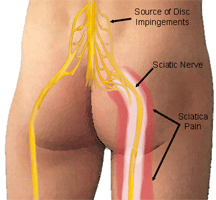One of the most common presentations of pain to our clinic is described as ‘sciatica’. Sciatica is typically pain that radiates through the buttock and down the back of the leg, sometimes into the foot and toes.
I would like to distinguish between true sciatica and other causes of pain down the leg.
What is sciatica?
Sciatica refers to the pain that radiates along the path of the sciatic nerve, which branches from your lower back through your hips and buttocks and down each leg. Typically, sciatica affects only one side of your body. Sciatica most commonly occurs when a herniated disk, bone spur on the spine or narrowing of the spine (spinal stenosis) compresses part of the nerve. This causes inflammation, pain and often some numbness in the affected leg or foot.
What are the symptoms?
- Pain that radiates from your lower spine to your buttock and down the back of your leg is the hallmark of sciatica.
- The pain can vary widely, from a mild ache to a sharp, burning sensation or excruciating pain.
- Sometimes it can feel like a jolt or electric shock. It can be worse when you cough or sneeze, and prolonged sitting can aggravate symptoms.
- Some people also have numbness, tingling or muscle weakness in the affected leg or foot. You might have pain in one part of your leg and numbness in another.
Other causes of posterior leg pain
There are a number of things that can mimic sciatica, listed below are only a few:-
Piriformis syndrome – a neuromuscular disorder that occurs when the sciatic nerve is compressed or irritated by the piriformis muscle which is in the buttock causing pain, tingling and numbness in the buttocks along the path of the sciatic nerve travelling into the posterior thigh and leg.
Gluteal syndromes – pressure on any of the buttock muscles can produce a referred pain pattern. It can be an aching pain that follows the trigger points.
- Gluteus maximus – pain referral into the buttock or the coccyx area.
- Gluteus medius – pain referral over the sacrum and sometimes through the mid-buttock area and the upper portion of the back of the thigh.
- Gluteus minimus – pain referral to the lower portion of the buttock, the back of the thigh and sometimes into the back of the calf.
Sacroiliac dysfunction – the sacroiliac joints sit at the base of the spine and connect the sacrum to the pelvis. Improper movement such as too much or too little movement of these joints can produce pain which can radiate into the lower back, buttock and down the back of the legs.
Bursitis of the hip – is inflammation of the bursa of the hip. It can present as aching or burning pain in the top and side of the thigh and sometimes into the buttock that can radiate down to the knee.
What to do?
Although the pain associated with sciatic can be severe, most cases resolve with non-operative treatments within weeks.
If you are experiencing any of the symptoms above it would be worth making an appointment with one of our Osteopaths or Chiropractors at Body of Life Health Centre for an examination and treatment. We can provide a diagnosis and information to educate you on how to best manage your sciatica or other cause of pain.
Get immediate medical care if:-
- You have sudden, severe pain in your lower back or leg with numbness or muscle weakness in your leg.
- The pain follows a violent injury, such as a traffic accident.
- You have trouble controlling your bowels or bladder
- You have any numbness in your groin area.
Article written by Dr Kristy Buist (Osteopath)


